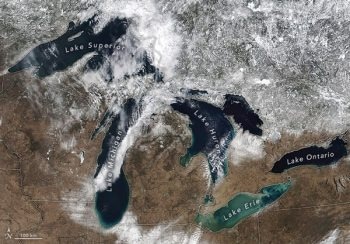"Forever chemicals" like PFAS (Perfluoroalkyl and polyfluoroalkyl substances) are being deposited into the Great Lakes through precipitation, affecting the freshwater millions in the US and Canada rely on. Although precipitation introduces similar amounts of PFAS to each lake, the rates at which these chemicals are removed vary, with some lakes accumulating PFAS while others are better at eliminating them. The study was published in ACS’ Environmental Science & Technology.
 “Forever chemicals” are being deposited into the Great Lakes by precipitation, which could affect the people who rely on them as a source of freshwater. Image Credit: NASA’s Earth Observatory
“Forever chemicals” are being deposited into the Great Lakes by precipitation, which could affect the people who rely on them as a source of freshwater. Image Credit: NASA’s Earth Observatory
PFAS have emerged as persistent air, water, and soil pollutants. Their high stability allows them to travel through the water cycle, eventually contaminating drinking water sources and precipitation. The study reveals that precipitation deposits similar quantities of PFAS into each of the Great Lakes, but the rates at which these chemicals are removed from the lakes vary.
There is evidence linking PFAS consumption to adverse health effects. Furthermore, the US Environmental Protection Agency (EPA) designated two permanent chemicals, PFOS and PFOA, as dangerous substances in April 2024 and set limitations on their amounts in drinking water.
The EPA estimates that 10% and 30% of the populations of the United States and Canada, respectively, live in the basin area surrounding the Great Lakes, which are a significant source of freshwater for both countries. Previous research has shown that these lakes contain PFAS.
However, Marta Venier of Indiana University and her American and Canadian colleagues were interested in learning more about the chemicals' origins and destinations.
Five locations around the Great Lakes in the United States were sampled between 2021 and 2022: Chicago; Cleveland; Sturgeon Point, NY; Eagle Harbor, Mich.; and Sleeping Bear Dunes, Mich. A total of 207 precipitation samples and 60 air samples were collected from these locations.
In the same time frame, 87 distinct water samples from each of the five Great Lakes were gathered. After examining every sample for 41 different PFAS categories, the scientists discovered:
- PFAS concentrations in precipitation samples mostly did not change between sites, indicating that the substances are present at comparable amounts independent of population density.
- There appears to be a considerable correlation between population density and airborne PFAS, with Cleveland having the highest median concentration of PFAS in air samples and Sleeping Bear Dunes having the lowest.
- PFAS concentrations in lake water samples showed that Lake Ontario had the greatest concentration, followed by Lake Michigan, Lake Erie, Lake Huron, and Lake Superior.
- While the concentration of PFBA, a substitute PFAS, remained high in lake water, the concentration of PFOS and PFOA declined in comparison to data from earlier investigations dating back to 2005, indicating the possibility of additional regulation efforts.
PFAS are eliminated by sedimentation, which involves their sticking to particles as they settle to the lakebed or flowing out through connected channels. The scientists concluded that the main way PFAS enter the lakes is through aerial deposition from precipitation. According to their calculations, PFAS are generally collecting in the northernmost lakes, which include Superior, Michigan, and Huron.
Lake Ontario, located further south, mostly eliminates the compounds, while Lake Erie's levels stay constant. According to the researchers, this analysis may guide future initiatives and regulations meant to lessen the impact of PFAS in the Great Lakes.
The research was funded by the Great Lakes Restoration Initiative, which is part of the US Environmental Protection Agency’s Great Lakes National Program Office.
Journal Reference:
Xia, C., et al. (2024) The Ins and Outs of Per- and Polyfluoroalkyl Substances in the Great Lakes: The Role of Atmospheric Deposition. ACS' Environmental Science & Technology. doi.org/10.1021/acs.est.3c10098.